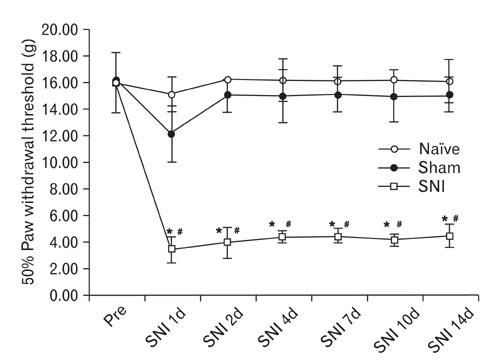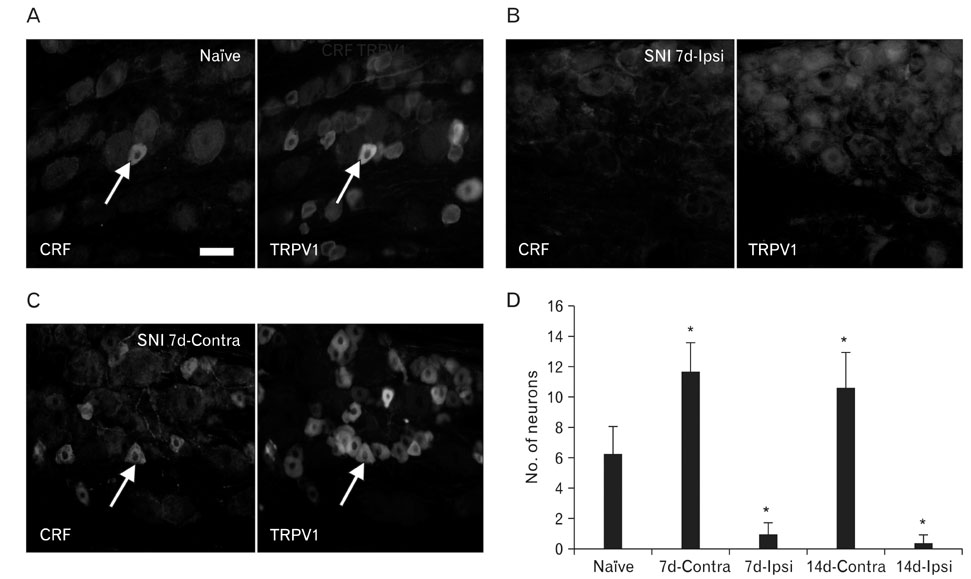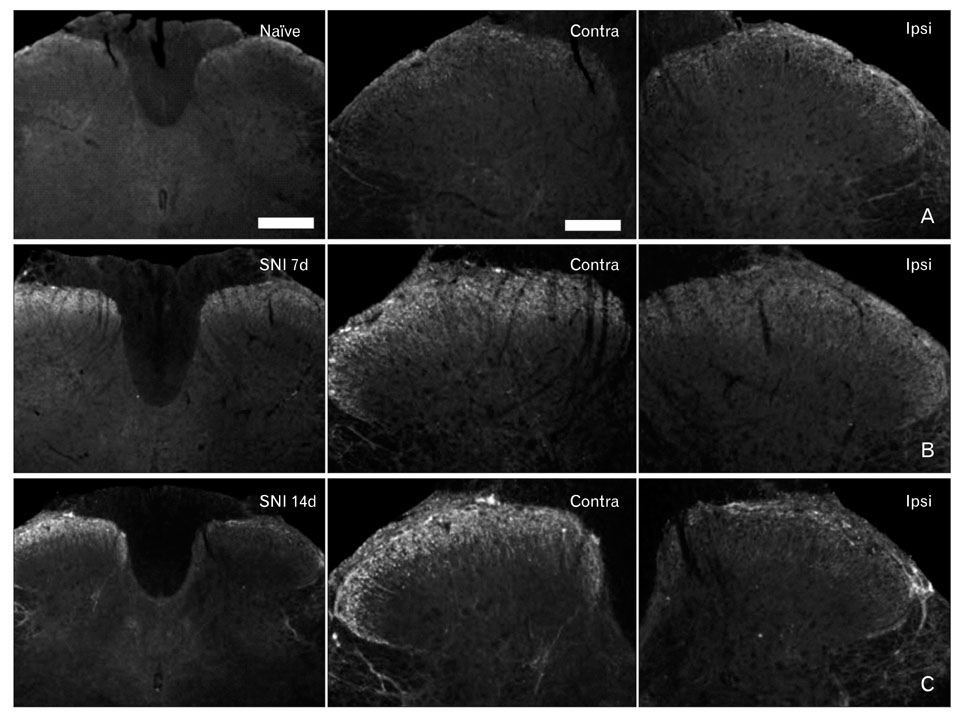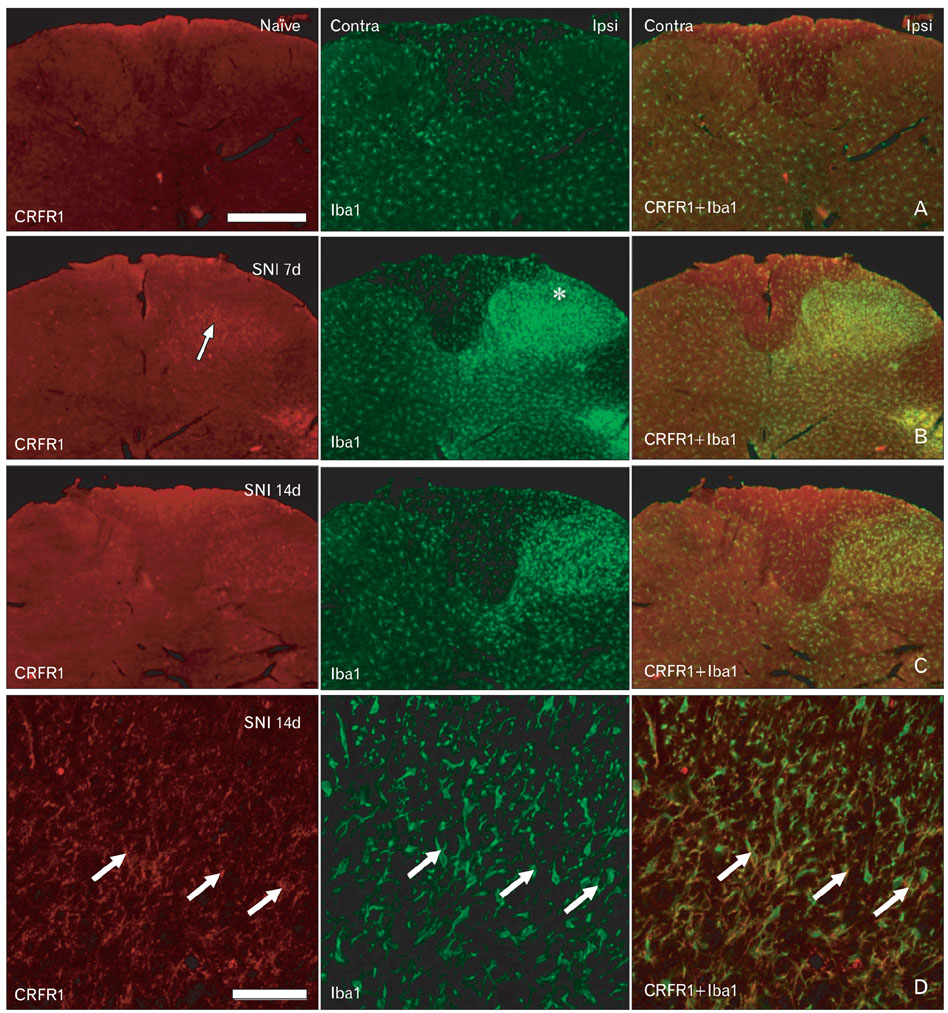Anat Cell Biol.
2011 Mar;44(1):60-68. 10.5115/acb.2011.44.1.60.
The expression of corticotropin-releasing factor and its receptors in the spinal cord and dorsal root ganglion in a rat model of neuropathic pain
- Affiliations
-
- 1Department of Anatomy and Cell Biology, College of Medicine, Hanyang University, Seoul, Korea. hwangsj@hanyang.ac.kr
- KMID: 2168869
- DOI: http://doi.org/10.5115/acb.2011.44.1.60
Abstract
- Corticotropin-releasing factor (CRF) is a peptide involved in the activation of the hypothalamic-pituitary-adrenal (HPA) axis. CRF is distributed not only along the HPA axis but also throughout pain-relevant anatomical sites. CRF elicits potent antinociception at the three main levels of pain transmissions: namely, the brain, spinal cord, and peripheral sensory neurons. The widespread distribution of CRF receptors 1 and 2 in the brain offers several targets wherein CRF could alter pain, some of which may be independent of the HPA axis. In this study, we assessed the expression of CRF and its receptors, CRF receptor type (CRFR)1 and CRFR2, in the spinal dorsal horn and dorsal root ganglion (DRG) in a rat model of neuropathic pain induced by spinal nerve injury (SNI). CRF was expressed in a few DRG neurons and primary afferent fibers in the dorsal horns of nasmall yi, Ukrainianve rats, and the CRF-positive neurons in DRG and fibers in the spinal dorsal horn were found to have increased after SNI. CRFR1 was not expressed in DRG or the dorsal horn and CRFR2 was expressed weakly in the small neurons in DRG in the nasmall yi, Ukrainianve rats. After SNI, CRFR1 was expressed in the activated microglia in the ipsilateral dorsal horn, and immunoreaction for CRFR2 was increased in the contralateral DRG following SNI. Consequently, it has been suggested that the increased expression of CRF and CRFR2 in DRG neurons and primary afferent fibers in dorsal horn, and CRFR1 in the activated microglia, may be involved in the mediation of stress responses as well as in microglial activation in the neuropathic pain state following SNI.
Keyword
MeSH Terms
-
Animals
Axis, Cervical Vertebra
Brain
Corticotropin-Releasing Hormone
Diagnosis-Related Groups
Ganglia, Spinal
Horns
Microglia
Negotiating
Neuralgia
Neurons
Rats
Receptors, Corticotropin-Releasing Hormone
Sensory Receptor Cells
Spinal Cord
Spinal Nerve Roots
Spinal Nerves
Corticotropin-Releasing Hormone
Receptors, Corticotropin-Releasing Hormone
Figure
Reference
-
1. Perrin MH, Sutton SW, Cervini LA, Rivier JE, Vale WW. Comparison of an agonist, urocortin, and an antagonist, astressin, as radioligands for characterization of corticotropin-releasing factor receptors. J Pharmacol Exp Ther. 1999. 288:729–734.2. Perrin MH, Vale WW. Corticotropin releasing factor receptors and their ligand family. Ann N Y Acad Sci. 1999. 885:312–328.3. Emeric-Sauval E. Corticotropin-releasing factor (CRF): a review. Psychoneuroendocrinology. 1986. 11:277–294.4. Olschowka JA, O'Donohue TL, Mueller GP, Jacobowitz DM. The distribution of corticotropin releasing factor-like immunoreactive neurons in rat brain. Peptides. 1982. 3:995–1015.5. Merchenthaler I, Hynes MA, Vigh S, Shally AV, Petrusz P. Immunocytochemical localization of corticotropin releasing factor (CRF) in the rat spinal cord. Brain Res. 1983. 275:373–377.6. Skofitsch G, Zamir N, Helke CJ, Savitt JM, Jacobowitz DM. Corticotropin releasing factor-like immunoreactivity in sensory ganglia and capsaicin sensitive neurons of the rat central nervous system: colocalization with other neuropeptides. Peptides. 1985. 6:307–318.7. Kawatani M, Suzuki T, de Groat WC. Corticotropin releasing factor-like immunoreactivity in afferent projections to the sacral spinal cord of the cat. J Auton Nerv Syst. 1996. 61:218–226.8. De Souza EB. Corticotropin-releasing factor receptors in the rat central nervous system: characterization and regional distribution. J Neurosci. 1987. 7:88–100.9. Bell JA, de Souza EB. Functional corticotropin-releasing factor receptors in neonatal rat spinal cord. Peptides. 1988. 9:1317–1322.10. Lariviere WR, Melzack R. The role of corticotropin-releasing factor in pain and analgesia. Pain. 2000. 84:1–12.11. Amit Z, Galina ZH. Stress-induced analgesia: adaptive pain suppression. Physiol Rev. 1986. 66:1091–1120.12. Mousa SA, Bopaiah CP, Richter JF, Yamdeu RS, Schäfer M. Inhibition of inflammatory pain by CRF at peripheral, spinal and supraspinal sites: involvement of areas coexpressing CRF receptors and opioid peptides. Neuropsychopharmacology. 2007. 32:2530–2542.13. Ji G, Neugebauer V. Differential effects of CRF1 and CRF2 receptor antagonists on pain-related sensitization of neurons in the central nucleus of the amygdala. J Neurophysiol. 2007. 97:3893–3904.14. Fu Y, Neugebauer V. Differential mechanisms of CRF1 and CRF2 receptor functions in the amygdala in pain-related synaptic facilitation and behavior. J Neurosci. 2008. 28:3861–3876.15. Studeny S, Vizzard MA. Corticotropin-releasing factor (CRF) expression in postnatal and adult rat sacral parasympathetic nucleus (SPN). Cell Tissue Res. 2005. 322:339–352.16. Korosi A, Kozicz T, Richter J, Veening JG, Olivier B, Roubos EW. Corticotropin-releasing factor, urocortin 1, and their receptors in the mouse spinal cord. J Comp Neurol. 2007. 502:973–989.17. Sengupta JN. Visceral pain: the neurophysiological mechanism. Handb Exp Pharmacol. 2009. (194):31–74.18. Cabot PJ. Immune-derived opioids and peripheral antinociception. Clin Exp Pharmacol Physiol. 2001. 28:230–232.19. Ock J, Lee H, Kim S, Lee WH, Choi DK, Park EJ, Kim SH, Kim IK, Suk K. Induction of microglial apoptosis by corticotropin-releasing hormone. J Neurochem. 2006. 98:962–972.20. Narita M, Yoshida T, Nakajima M, Narita M, Miyatake M, Takagi T, Yajima Y, Suzuki T. Direct evidence for spinal cord microglia in the development of a neuropathic pain-like state in mice. J Neurochem. 2006. 97:1337–1348.21. Kim SH, Chung JM. An experimental model for peripheral neuropathy produced by segmental spinal nerve ligation in the rat. Pain. 1992. 50:355–363.22. Lee SE, Kim JH. Involvement of substance P and calcitonin gene-related peptide in development and maintenance of neuropathic pain from spinal nerve injury model of rat. Neurosci Res. 2007. 58:245–249.23. Chaplan SR, Bach FW, Pogrel JW, Chung JM, Yaksh TL. Quantitative assessment of tactile allodynia in the rat paw. J Neurosci Methods. 1994. 53:55–63.24. Ikeda H, Kusudo K, Ryu PD, Murase K. Effects of corticotropin-releasing factor on plasticity of optically recorded neuronal activity in the substantia gelatinosa of rat spinal cord slices. Pain. 2003. 106:197–207.25. Gillardon F, Klimaschewski L, Wickert H, Krajewski S, Reed JC, Zimmermann M. Expression pattern of candidate cell death effector proteins Bax, Bcl-2, Bcl-X, and c-Jun in sensory and motor neurons following sciatic nerve transection in the rat. Brain Res. 1996. 739:244–250.26. Zimmermann M. Pathobiology of neuropathic pain. Eur J Pharmacol. 2001. 429:23–37.27. Du F, Yin L, Shi M, Cheng H, Xu X, Liu Z, Zhang G, Wu Z, Feng G, Zhao G. Involvement of microglial cells in infrasonic noise-induced stress via upregulated expression of corticotrophin releasing hormone type 1 receptor. Neuroscience. 2010. 167:909–919.28. Stevens SL, Shaw TE, Dykhuizen E, Lessov NS, Hill JK, Wurst W, Stenzel-Poore MP. Reduced cerebral injury in CRH-R1 deficient mice after focal ischemia: a potential link to microglia and atrocytes that express CRH-R1. J Cereb Blood Flow Metab. 2003. 23:1151–1159.29. Kreutzberg GW. Microglia: a sensor for pathological events in the CNS. Trends Neurosci. 1996. 19:312–318.30. Hains BC, Waxman SG. Activated microglia contribute to the maintenance of chronic pain after spinal cord injury. J Neurosci. 2006. 26:4308–4317.31. Schreiber KL, Beitz AJ, Wilcox GL. Activation of spinal microglia in a murine model of peripheral inflammation-induced, long-lasting contralateral allodynia. Neurosci Lett. 2008. 440:63–67.32. Ledeboer A, Sloane EM, Milligan ED, Frank MG, Mahony JH, Maier SF, Watkins LR. Minocycline attenuates mechanical allodynia and proinflammatory cytokine expression in rat models of pain facilitation. Pain. 2005. 115:71–83.33. Festoff BW, Ameenuddin S, Arnold PM, Wong A, Santacruz KS, Citron BA. Minocycline neuroprotects, reduces microgliosis, and inhibits caspase protease expression early after spinal cord injury. J Neurochem. 2006. 97:1314–1326.
- Full Text Links
- Actions
-
Cited
- CITED
-
- Close
- Share
- Similar articles
-
- Studies on the Morphological Changes of Neurons in Dorsal Root Ganglion and Spinal Dorsal Horn of the Rat with an Experimental Peripheral Neuropathy
- Identification of Differentially Expressed Genes by Gabapentin in Cultured Dorsal Root Ganglion in a Rat Neuropathic Pain Model
- Study on the nNOS Expression in the Rat Spinal Cord of the Spinal Nerve Ligation Model with Neuropathic Pain and the Dorsal Rhizotomy
- Changes in the alpha2-Adrenergic Receptor Subtypes Gene Expression in Rat Dorsal Root Ganglion and Spinal Cord in an Experimental Model of Neuropathic Pain
- Studies on the changes of c-fos protein in spinal cord and neurotransmitter in dorsal root ganglion of the rat with an experimental peripheral neuropathy






